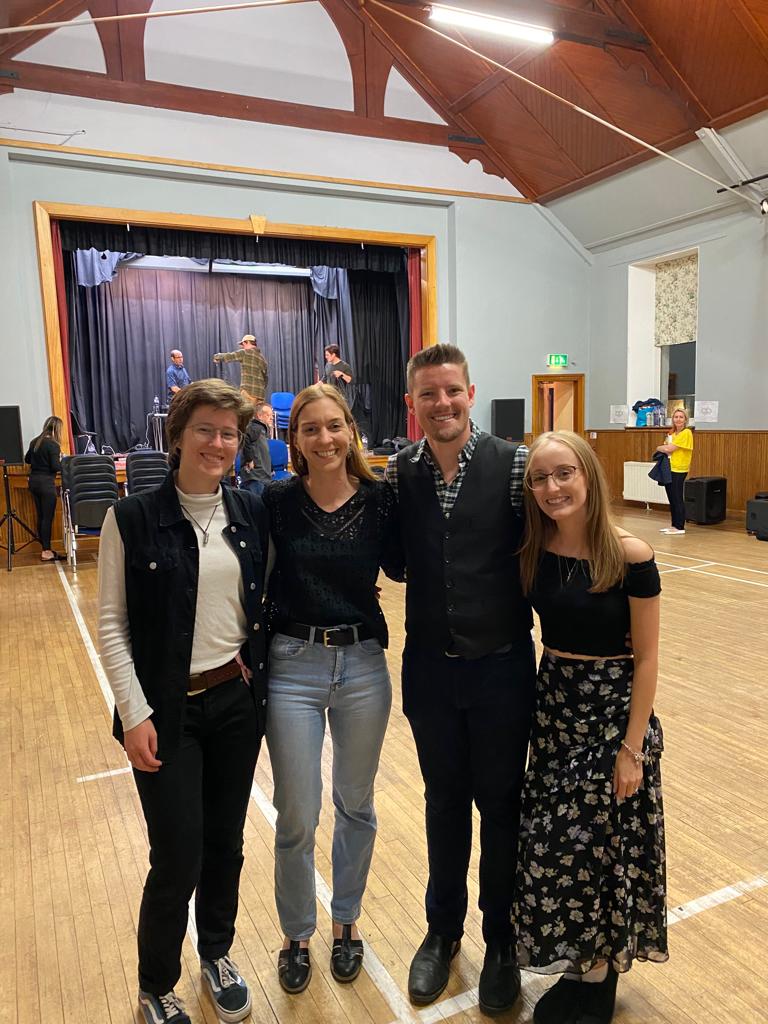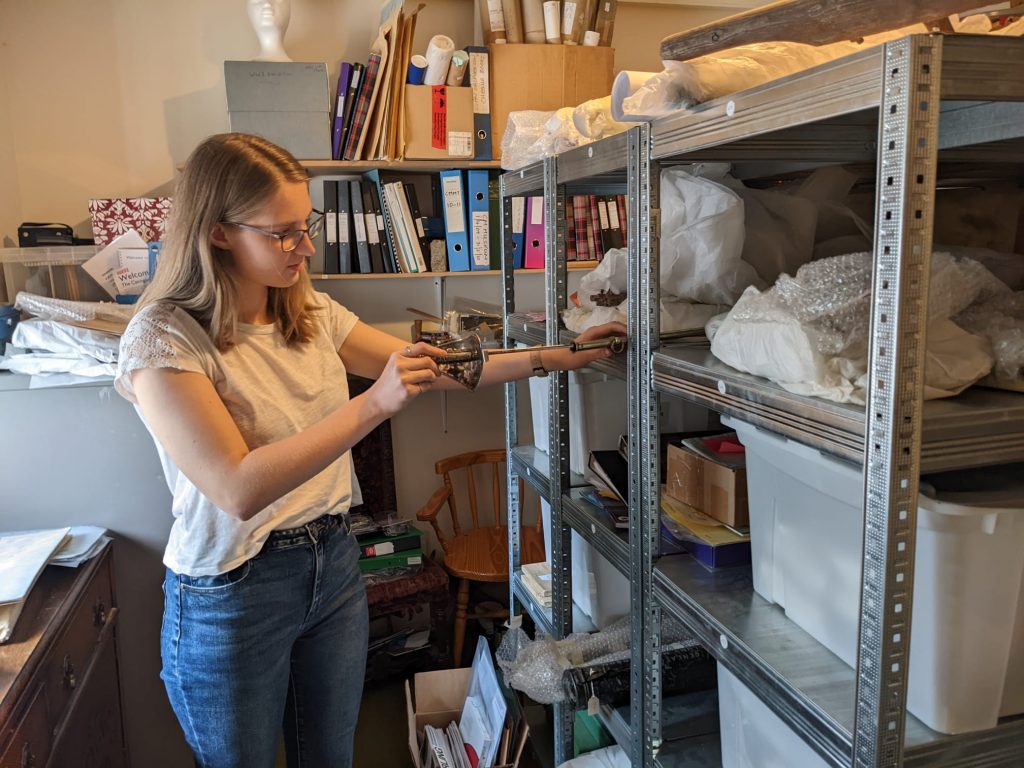
We’re delighted to welcome Aileen-Laura Schäfer (one of our climate ambassadors and former curator at Clan MacPherson Museum) to tell us about the benefits of working with international student interns and the process, if you think this would work in your organisation, for applying.
Two years ago, I found myself as the only person on site full-time in a small independent museum. Operating with limited resources, staff and volunteers, but a million ideas for projects and events, I shared a problem, many of us face across museums in the Highlands. Therefore, I decided to find a way that would not only enrich the museum’s capacity, but also provide a valuable and fair opportunity for young talent in the sector. After some correspondence with a German university, we initiated an internship program, welcoming two student interns, who worked with me at the museum full-time, for two months each, and the experience proved a great one for all involved.
The collaboration with the English department of the university, laid the foundation for an internship program that would benefit both the museum and the students. A crucial aspect, especially for a small museum like ours, was the provision of a scholarship from the sending institution, covering the living expenses for the student intern. This financial support made the program accessible to both, students who might not have otherwise been able to participate and a museum that could not have easily supported an additional member of staff. Recognizing the challenges and costs of finding lodging in the Highlands, I offered the interns to stay in my spare room, free of charge, during the time of the internship.
Despite a tight recruitment schedule to allow enough time for the successful applicants to sort out scholarships, visas and get organised, we received a great response of 20 highly motivated applications in less than 14 days. Selecting only two interns was a challenging task. Taking time to get to know them meant gaining insights into their main interests though, and allowed for setting the stage for a personalised and enriching experience.
Four months later, the first intern finally arrived at the museum, with a huge suitcase and a lot of enthusiasm. The first week of the internship was dedicated to introducing the students to the museum’s regular activities and tasks, particularly in front-of-house responsibilities. They largely shadowed me during this first week, through which they also gained brief insights into behind-the-scenes activities and I tried setting time aside each day for them, to get familiar with the place and the exhibition and to chat about the different aspects of museum work. A crucial feedback session after this initial period allowed us to tailor their experiences further to their interests and to talk through the tasks, I had planned for them to get involved in, in the weeks to come.
The unique backgrounds of our interns added diverse dimensions to our small museum. One, an English literature student, became involved in literature-related events, the library, book-related objects, and publicity. Serendipitously, we were in the final stages of self-publishing a history book, and her contributions were invaluable to the successful launch.


The second intern, on the path to becoming a teacher, focused on kid-related projects. From designing a child-friendly museum guide to preparing events for school-visits and contributing to child-friendly museum interpretations, her impact on our educational initiatives was profound.
Their contributions did not end with their internships. Both interns, having become valued members of our team, continued to volunteer remotely after their official term. Their remote volunteering activities included social media, publicity and translations amongst other things, showcasing a sustained commitment to the museum’s success.
Beyond the tangible contributions of an additional full-time team member, witnessing their personal and professional development was immensely gratifying. As interns, their confidence grew, and their opinions were valuable additions to our team discussions. Moreover, the benefits of having interns extended far beyond these aspects. Despite initial concerns about the capacity for supervision and introduction with just one person on site full-time, the interns’ contributions proved to be invaluable. The time and effort invested in their onboarding and guidance were more than compensated by the fresh perspectives, innovative ideas, and increased productivity they brought to the museum. Their involvement not only lightened the workload but also introduced novel approaches to tasks, enhancing the overall creativity and effectiveness of our operations. To me, the internship-programme showed in a great way that the addition of enthusiastic individuals can lead to significant positive outcomes.
For me personally, there were great merits too, as the introduction period, the creation of schedules, and the weekly feedback sessions prompted me to reevaluate and refine my work processes. Breaking down tasks into steps and engaging in regular reflections streamlined daily operations and the drafting of clear to-do lists, checklists, and procedure plans became second nature, which was immensely helpful for all our volunteers as well.
The positive experience resonated so deeply that, without re-advertising, other students expressed interest in future internships.
The ripple effect of this program reached even further, as the following year the university organised an excursion with one of their seminars, bringing a group of 16 students to visit our museum for workshops and talks. This not only highlighted the success of our internship program but also solidified the museum as a valuable educational resource. As I reflect on this process, I can very much recommend any other small museums to consider inviting interns to their organisation.
Finding an intern, the process
It all began with the creation of a comprehensive vacancy, detailing the nature of the internship and its requirements. Following the submission of the vacancy to the university and their distribution amongst the relevant students, the recruitment process unfolded. It involved the regular stages of shortlisting, communication with candidates, and interviews. Once the successful candidates were identified, a Letter of Acceptance, outlining the internship and most importantly, the exact dates, needs to be sent to the interns. This document is pivotal in facilitating their scholarship and visa applications, a process that spanned several months but required minimal direct involvement from the museum. It therefore is important that the following information is contained in the letter: exact start date, exact end date, any accommodation or pay, that the language for the internship will be English, the address of the museum, the line-manager of the intern and that the museum will not be able to aid with travel and visa processes.
Nearing the time of the internship a form sent by the university needed to be signed to confirm the details, and the consulate sent straightforward two-page forms to confirm visa details, at the beginning and end of the stay of each intern.
Throughout the internship, a structured process was in place to ensure ongoing communication and evaluation. Midway through, an Interim evaluation form from the interns’ university prompted a reflection on their performance. This involved answering multiple-choice questions and providing insights into their achievements. A similar comprehensive evaluation was conducted at the end of the internship. On the final day, each intern received a Letter of Recommendation, a common practice in Germany for future job applications. Interns are tasked with crafting an internship report resembling a diary by the university, but the museum has no responsibility in this. Regular feedback sessions, which, though not obligatory, can be a valuable practice contributing to a positive work environment.
If you would like to know more, please get in touch.
